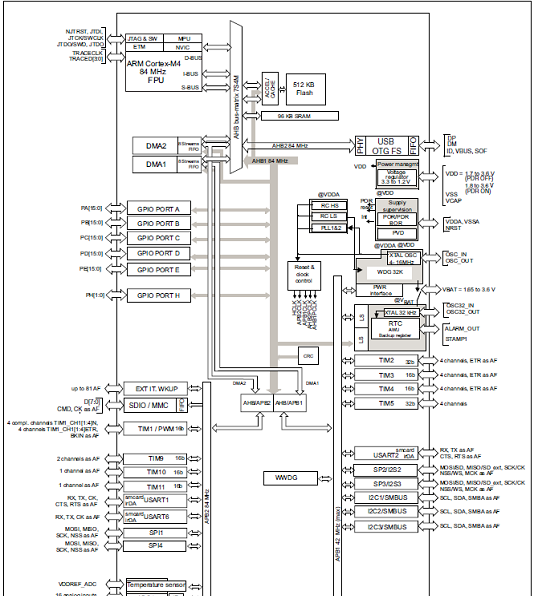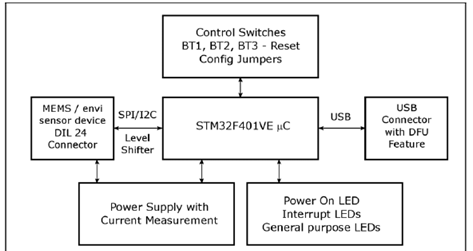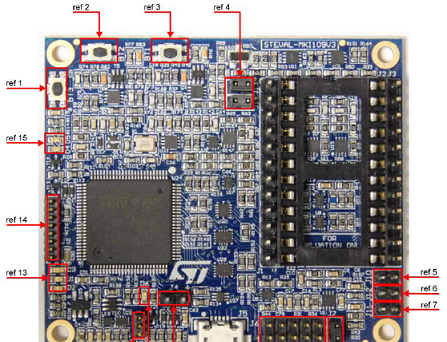ST STM32F401VE MEMS专用评估方案
 69
69
 拍明
拍明
原标题:ST STM32F401VE MEMS专用评估方案
ST公司的stm32F401VE是基于ARM® Cortex® -M4 32位RISC核的高性能mcu,工作频率高达84MHz.它的Cortex®-M4核具有单精度浮点单元(FPU),支持所有的ARM单精度数据处理指令和数据类型,也能执行全部DSP指令和存储器保护单元(MPU),从而增强了应按用安全性.器件集成了高速嵌入存储器(512KB闪存,96KB SRAM)和多种增强I/O和外设,以连接两个APB总线,两个AHB总线和32位多AHB总线矩阵.所有器件提供一个12位ADC,低功耗RTC,六个通用16位计时器,包括一个用于马达控制的PWM计时器和两个通用32位计时器以及多种标准和高档通信接口.主要用在马达驱动和应用控制,医疗设备,PLC,逆变器和断路器,打印机和扫描仪,家庭音频设备,手机传感器集线器以及告警系统,视频互连和HVAC等.本文介绍了STM32F401VE主要特性,框图,MEMS评估母板STEVAL-MKI109V3主要特性,框图,主要元件表,电路图和PCB丝印图.
The STM32F401XD/XE devices are based on the high-performance ARM® Cortex® -M4 32- bit RISC core operating at a frequency of up to 84 MHz. Its Cortex®-M4 core features a Floating point unit (FPU) single precision which supports all ARM single-precision data-processing instructions and data types. It also implements a full set of DSP instructions and a memory protection unit (MPU) which enhances application security. The STM32F401xD/xE incorporate high-speed embedded memories (512 Kbytes of Flash memory, 96 Kbytes of SRAM), and an extensive range of enhanced I/Os and peripherals connected to two APB buses, two AHB buses and a 32-bit multi-AHB bus matrix. All devices offer one 12-bit ADC, a low-power RTC, six general-purpose 16-bit timers including one PWM timer for motor control, two general-purpose 32-bit timers. They also feature standard and advanced communication interfaces.
• Up to three I2Cs
• Up to four SPIs
• Two full duplex I2Ss. To achieve audio class accuracy, the I2S peripherals can be clocked via a dedicated internal audio PLL or via an external clock to allow synchronization.
• Three USARTs
• SDIO interface
• USB 2.0 OTG full speed interface Refer to for the peripherals available for each part number.
The STM32F401xD/xEoperate in the –40 to +105℃ temperature range from a 1.7 (PDR OFF) to 3.6 V power supply. A comprehensive set of power-saving mode allows the design of low-power applications.These features make the STM32F401xD/xE microcontrollers suitable for a wide range of applications:
• Motor drive and application control
• Medical equipment
• Industrial applications: PLC, inverters, circuit breakers
• Printers, and scanners
• Alarm systems, video intercom, and HVAC
• Home audio appliances
• Mobile phone sensor hub
STM32F401VE主要特性:
• Core: ARM® 32-bit Cortex®-M4 CPU with FPU, Adaptive real-time accelerator (ART Accelerator™) allowing 0-wait state execution from Flash memory, frequency up to 84 MHz, memory protection unit, 105 DMIPS/1.25 DMIPS/MHz (Dhrystone 2.1),and DSP instructions
• Memories
– up to 512 Kbytes of Flash memory
– up to 96 Kbytes of SRAM
• Clock, reset and supply management
– 1.7 V to 3.6 V application supply and I/Os
– POR, PDR, PVD and BOR
– 4-to-26 MHz crystal oscillator
– Internal 16 MHz factory-trimmed RC
– 32 kHz oscillator for RTC with calibration
– Internal 32 kHz RC with calibration
• Power consumption
– Run: 146 μA/MHz (peripheral off)
– Stop (Flash in Stop mode, fast wakeup time): 42 μATyp @25C;65 μA max @25℃
– Stop (Flash in Deep power down mode, fast wakeup time): down to 10 μA @25 ℃;30 μA max @25℃
– Standby: 2.4 μA @25℃ /1.7 V without RTC; 12 μA @85℃ @1.7 V
– VBAT supply for RTC: 1 μA @25℃
• 1×12-bit, 2.4 MSPS A/D converter: up to 16 channels
• General-purpose DMA: 16-stream DMA controllers with FIFOs and burst support
• Up to 11 timers: up to six 16-bit, two 32-bit timers up to 84 MHz, each with up to four IC/OC/PWM or pulse counter and quadrature (incremental) encoder input, two watchdog timers (independent and window) and a SysTick timer
• Debug mode
– Serial wire debug (SWD) & JTAG interfaces
– Cortex ? -M4 Embedded Trace Macrocell™
• Up to 81 I/O ports with interrupt capability
– Up to 78 fast I/Os up to 42 MHz
– All I/O ports are 5 V-tolerant
• Up to 12 communication interfaces
– Up to 3 x I2C interfaces (SMBus/PMBus)
– Up to 3 USARTs (2 x 10.5 Mbit/s, 1 x 5.25 Mbit/s), ISO 7816 interface, LIN, IrDA, modem control)
– Up to 4 SPIs (up to 42Mbit/s at fCPU = 84 MHz), SPI2 and SPI3 with muxed full-duplex I2S to achieve audio class accuracy via internal audio PLL or external clock – SDIO interface
– Advanced connectivity: USB 2.0 full-speed device/host/OTG controller with on-chip PHY • CRC calculation unit
• 96-bit unique ID
• RTC: subsecond accuracy, hardware calendar
• All packages (WLCSP49, LQFP64/100, UFQFPN48, UFBGA100) are ECOPACK®2

图1.STM32F401VE框图
MEMS评估母板STEVAL-MKI109V3
STEVAL-MKI109V3 Professional MEMS Tool motherboard for MEMS adapter boards The STEVAL-MKI109V3 motherboard provides users with a complete, ready-to-use platform for the evaluation ofSTMicroelectronics MEMS products.
It includes a high-performance 32-bit microcontroller which functions as a bridge between the sensors and a PC, on which youcan download and run the graphical user interface (GUI) or dedicated software routines for customized applications.
The board features a DIL24 socket to mount all available adapters for both digital and analog output MEMS devices.
The Professional MEMS Tool demonstration kit is based on the STM32F401VE microcontroller and can beconnected to a PC via USB. Data from MEMS sensors connected to the board can be read through the PC GUIprovided with the kit.
The Professional MEMS Tool also implements the DFU (device firmware upgrade) feature, so it can bereprogrammed with a new firmware release without the need to use a programmer.
The Professional MEMS Tool integrates:
• Six LEDs:
– two LEDs connected via FET buffers to the interrupt pins of digital adapters
– a power/USB LED
– three general-purpose LEDs for firmware state indication
• Three buttons:
– two user buttons on a dedicated GPIO of the microcontroller
– a microcontroller reset button
All the MEMS adapter pins are available on board connectors J1 and J3.

图1.MEMS评估母板STEVAL-MKI109V3框图

图2. MEMS评估母板STEVAL-MKI109V3外形图
图2 MEMS评估母板STEVAL-MKI109V3中主要元件:
1. Button BT3 is used to reset the STM32.
2. Button BT2 connected to STM32 GPIOs and available to the user. To enter DFU mode:
a. press buttons BT3 (Reset) and BT2 together
b. first release BT3 and then release BT2
3. BT1 connected to STM32 GPIOs and available to the user.
4. Jumpers J13 (VDD) and J14 (VDDIO) allow the user to measure the sensor current consumption byconnecting a multimeter in series with their terminals.
5. Jumper J10 is used as a general purpose input to manually set certain features for several MEMS adapters.
6. Jumper J12 is used as a general purpose input to manually set certain features for several MEMS adapters.
7. Jumper J11 is used to set the self-test feature during testing of Professional MEMS Tool PCB.
8. Jumper J7 is used to select either JTAG (JP7 open – NRST control not allowed from programmingconnector J6) or SWD mode (JP7 shorted – NRST control allowed from connector J6).
9. J6 connector can be used to reprogram the STM32 and debug the code through the JTAG or SWDprotocols.
10. Jumper J4 can be used to directly supply the board (from 4.5 V to 5.5 V) instead of through the USBconnector.
11. LED D6 lights up when the board is powered.
12. J8 connector can be used for UART RX/TX communication.
13. LEDs D1, D2, and D3 are general-purpose LEDs used to indicate firmware states; e.g.:
a. LED D3 YELOW light up when specific firmware is selected from those available
b. LED D2 RED on indicates that the microcontroller is properly configured for communication with thesensor
c. LED D1 GREEN blinks according to the sensor data rate selected
14. J9 connector can be used for general purpose SPI bus.
15. LEDs D4 and D5 are directly connected to the interrupt pins of the MEMS digital adapters (if available on thesensor mounted on the adapter board).
STEVAL-MKI109V3 circuit schematic (1 of 8)
责任编辑:HanFeng
【免责声明】
1、本文内容、数据、图表等来源于网络引用或其他公开资料,版权归属原作者、原发表出处。若版权所有方对本文的引用持有异议,请联系拍明芯城(marketing@iczoom.com),本方将及时处理。
2、本文的引用仅供读者交流学习使用,不涉及商业目的。
3、本文内容仅代表作者观点,拍明芯城不对内容的准确性、可靠性或完整性提供明示或暗示的保证。读者阅读本文后做出的决定或行为,是基于自主意愿和独立判断做出的,请读者明确相关结果。
4、如需转载本方拥有版权的文章,请联系拍明芯城(marketing@iczoom.com)注明“转载原因”。未经允许私自转载拍明芯城将保留追究其法律责任的权利。
拍明芯城拥有对此声明的最终解释权。




 产品分类
产品分类















 2012- 2022 拍明芯城ICZOOM.com 版权所有 客服热线:400-693-8369 (9:00-18:00)
2012- 2022 拍明芯城ICZOOM.com 版权所有 客服热线:400-693-8369 (9:00-18:00)


